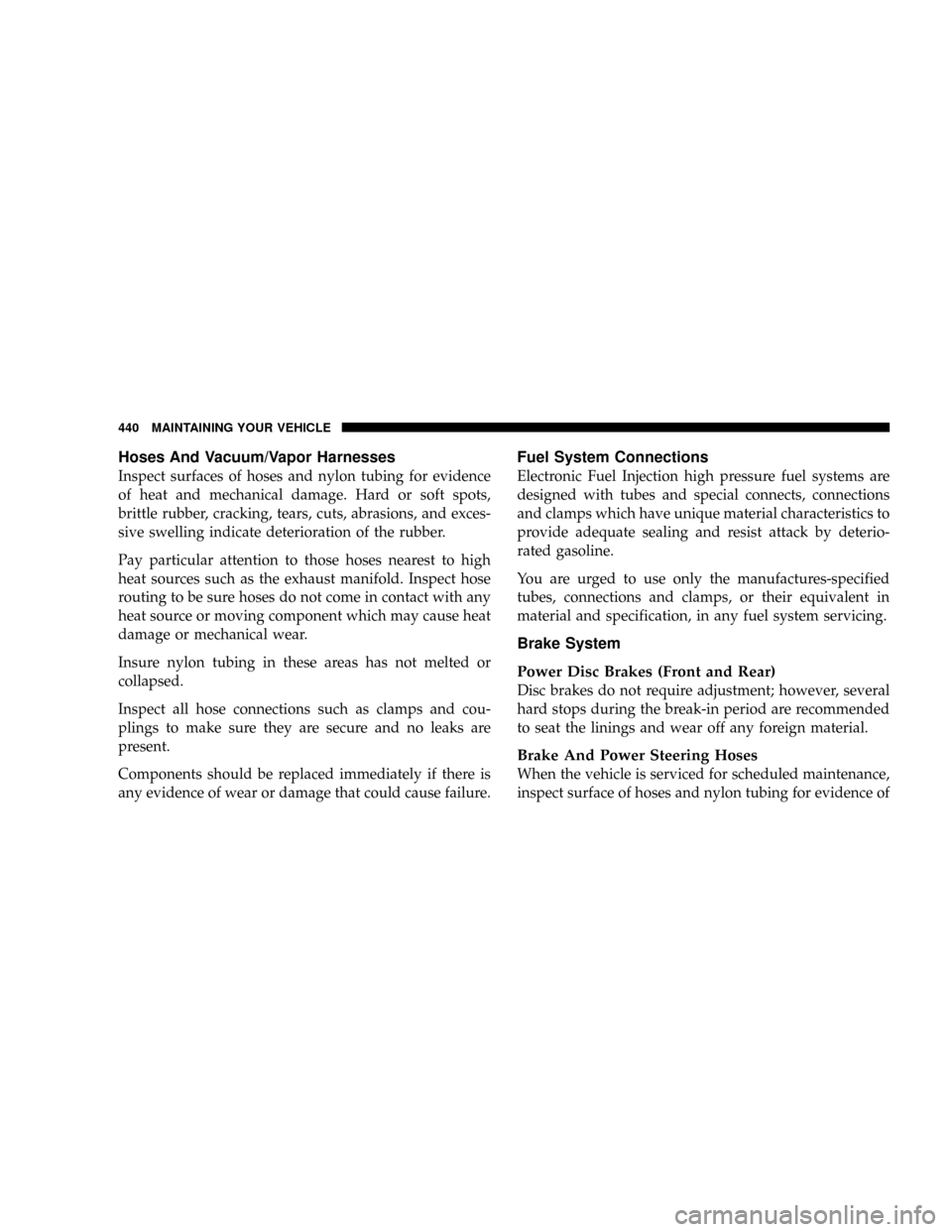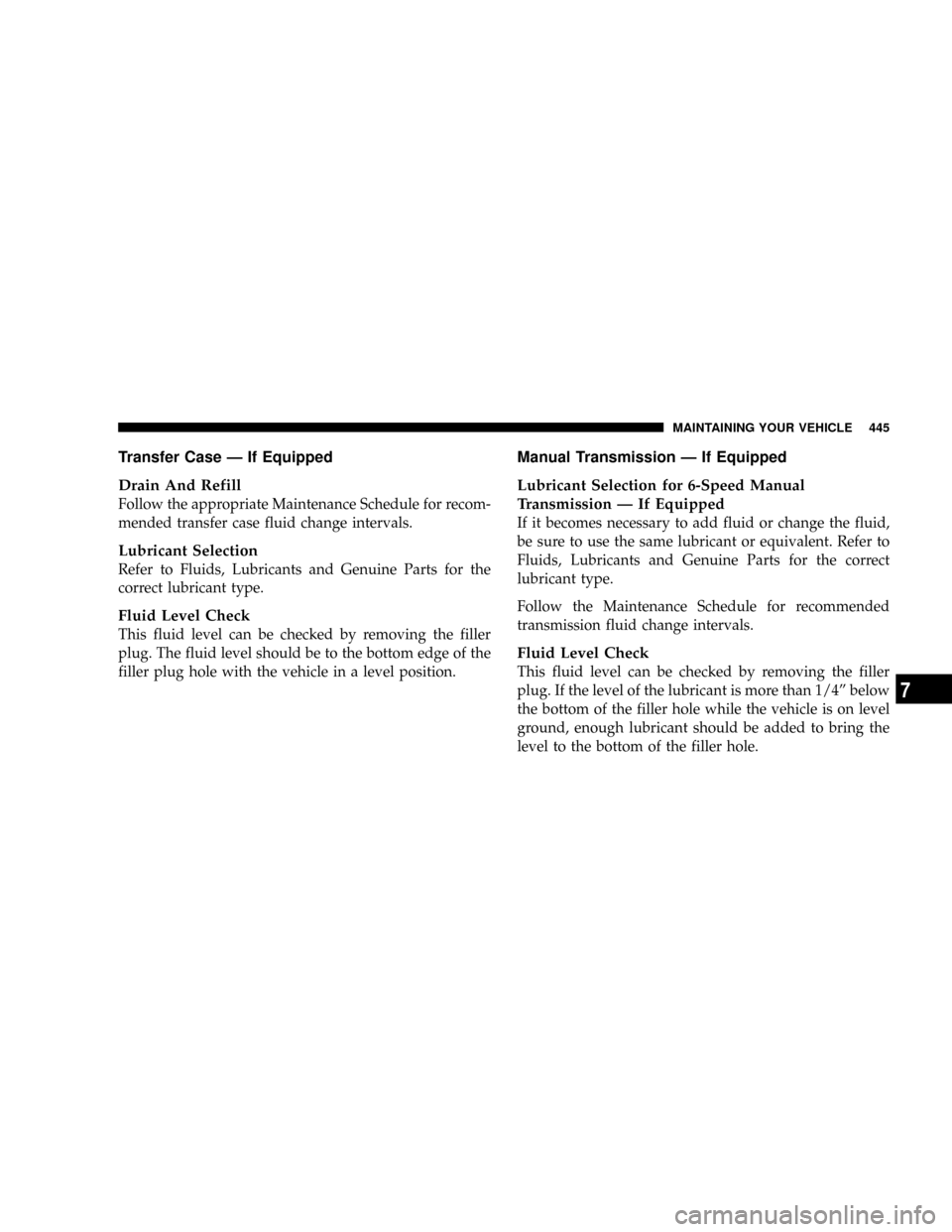Page 413 of 528

Drive Belts (Gas Engines)
Belt tension is controlled by means of an automatic
tensioner. No belt tension adjustments are required.
However, belt and belt tensioner condition should be
inspected at the specified intervals and replaced if re-
quired. See your authorized dealer for service.
At the mileage indicated in the maintenance schedule, all
belts and tensioner should be checked for condition.
Improper belt tension can cause belt slippage and failure.
Belts should be inspected for evidence of cuts, cracks,
glazing or frayed cords and replaced if there is indication
of damage which could result in belt failure. Low gen-
erator belt tension can cause battery failure.
Also check belt routing to make sure there is no interfer-
ence between the belts and other engine components.
Drive Belt (Diesel Engines)
Inspection
Check the belt for intersecting cracks.
²Transverse (across the belt width) cracks are accept-
able.
²Longitudinal (direction of belt length) cracks that
intersect with transverse cracks are NOT acceptable.
Replace the belt if it has unacceptable cracks, is frayed or
has pieces of material missing.
The engine speed sensor, located near the damper, should
be inspected for damage if a belt is frayed.
Engine Air Cleaner Filter (Gas Engines)
Follow the appropriate Maintenance Schedule for recom-
mended Air Cleaner Replacement intervals.
MAINTAINING YOUR VEHICLE 413
7
Page 430 of 528

Front Prop Shaft Lubrication
Lubricate the front driveshaft grease fitting at each oil
change listed in the appropriate Maintenance Schedule
for your vehicle. Use Moparttype MS-6560 (lithium
based grease), or equivalent.
Front Axle Universal Drive Joints And Ball Joints
The front axle universal joint and ball joints are perma-
nently lubricated and do not require servicing.
Body Lubrication
Locks and all body pivot points, including such items as
seat tracks, doors, liftgate and hood hinges, should be
lubricated periodically to assure quiet, easy operation
and to protect against rust and wear. Prior to the appli-
cation of any lubricant, the parts concerned should be
wiped clean to remove dust and grit; after lubricating
excess oil and grease should be removed. Particular
attention should also be given to hood latching compo-
nents to insure proper function. When performing other
underhood services, the hood latch, release mechanism
and safety catch should be cleaned and lubricated.
The external lock cylinders should be lubricated twice a
year, preferably in the fall and spring. Apply a small
Front Driveshaft Grease Fitting
430 MAINTAINING YOUR VEHICLE
Page 435 of 528

Cooling System Ð Drain, Flush and Refill
At the intervals shown on the Maintenance Schedules,
the system should be drained, flushed and refilled.
If the solution is dirty or contains a considerable amount
of sediment, clean and flush with a reliable cooling
system cleaner. Follow with a thorough rinsing to remove
all deposits and chemicals. Properly dispose of old
antifreeze solution.
Selection Of Coolant
Use only the manufacturers recommended coolant, refer
to Fluids, Lubricants and Genuine Parts for correct
coolant type.
CAUTION!
Mixing of coolants other than specified HOAT en-
gine coolants, may result in engine damage and may
decrease corrosion protection. If a non-HOAT coolant
is introduced into the cooling system in an emer-
gency, it should be replaced with the specified cool-
ant as soon as possible.
Do not use plain water alone or alcohol base engine
coolant (antifreeze) products. Do not use additional
rust inhibitors or antirust products, as they may not
be compatible with the radiator engine coolant and
may plug the radiator.
This vehicle has not been designed for use with
Propylene Glycol based coolants. Use of Propylene
Glycol based coolants is not recommended.
MAINTAINING YOUR VEHICLE 435
7
Page 440 of 528

Hoses And Vacuum/Vapor Harnesses
Inspect surfaces of hoses and nylon tubing for evidence
of heat and mechanical damage. Hard or soft spots,
brittle rubber, cracking, tears, cuts, abrasions, and exces-
sive swelling indicate deterioration of the rubber.
Pay particular attention to those hoses nearest to high
heat sources such as the exhaust manifold. Inspect hose
routing to be sure hoses do not come in contact with any
heat source or moving component which may cause heat
damage or mechanical wear.
Insure nylon tubing in these areas has not melted or
collapsed.
Inspect all hose connections such as clamps and cou-
plings to make sure they are secure and no leaks are
present.
Components should be replaced immediately if there is
any evidence of wear or damage that could cause failure.
Fuel System Connections
Electronic Fuel Injection high pressure fuel systems are
designed with tubes and special connects, connections
and clamps which have unique material characteristics to
provide adequate sealing and resist attack by deterio-
rated gasoline.
You are urged to use only the manufactures-specified
tubes, connections and clamps, or their equivalent in
material and specification, in any fuel system servicing.
Brake System
Power Disc Brakes (Front and Rear)
Disc brakes do not require adjustment; however, several
hard stops during the break-in period are recommended
to seat the linings and wear off any foreign material.
Brake And Power Steering Hoses
When the vehicle is serviced for scheduled maintenance,
inspect surface of hoses and nylon tubing for evidence of
440 MAINTAINING YOUR VEHICLE
Page 444 of 528

Drain And Refill
On 3500 vehicles the differential cover must be removed
to drain the axle fluid.
On 4500/5500 vehicles remove the lower bolt to drain the
axle fluid.Follow the appropriate Maintenance Schedule for recom-
mended front and rear axle fluid change intervals.
Lubricant Selection
Refer to Fluids, Lubricants and Genuine Parts for the
correct lubricant type.
NOTE:The presence of water in the gear lubricant will
result in corrosion and possible failure of differential
components. Operation of the vehicle in water, as may be
encountered in some off-highway types of service, will
require draining and refilling the axle to avoid damage.
Limited-Slip Differentials DO NOT REQUIREany
limited slip oil additive (friction modifiers).
NOTE:Slight noise and mild shuddering may be evi-
dent while turning a vehicle with limited slip differential
on concrete or dry pavement. These conditions should be
considered normal operation of the limited slip differen-
tial.
1 Ð 4500/5500 Rear Axle Fluid Fill Plug
2 Ð 4500/5500 Rear Axle Fluid Drain Plug 444 MAINTAINING YOUR VEHICLE
Page 445 of 528

Transfer Case Ð If Equipped
Drain And Refill
Follow the appropriate Maintenance Schedule for recom-
mended transfer case fluid change intervals.
Lubricant Selection
Refer to Fluids, Lubricants and Genuine Parts for the
correct lubricant type.
Fluid Level Check
This fluid level can be checked by removing the filler
plug. The fluid level should be to the bottom edge of the
filler plug hole with the vehicle in a level position.
Manual Transmission Ð If Equipped
Lubricant Selection for 6-Speed Manual
Transmission Ð If Equipped
If it becomes necessary to add fluid or change the fluid,
be sure to use the same lubricant or equivalent. Refer to
Fluids, Lubricants and Genuine Parts for the correct
lubricant type.
Follow the Maintenance Schedule for recommended
transmission fluid change intervals.
Fluid Level Check
This fluid level can be checked by removing the filler
plug. If the level of the lubricant is more than 1/4º below
the bottom of the filler hole while the vehicle is on level
ground, enough lubricant should be added to bring the
level to the bottom of the filler hole.
MAINTAINING YOUR VEHICLE 445
7
Page 448 of 528

Automatic Transmission Fluid and Filter Change
Follow the Maintenance Schedule for recommended
transmission fluid and filter change intervals.
NOTE:If the transmission is disassembled for any
reason, the fluid and filter should be changed.
Special Additives
The manufacturer recommends against the addition of
any additives to the transmission. Exception to this
policy is the use of special dyes to aid in detecting fluid
leaks. The use of transmission sealers should be avoided,
since they may adversely affect seals.
Automatic Transmission (Diesel Engine Only)
Selection Of Lubricant
Refer to Fluids, Lubricants and Genuine Parts for the
correct lubricant type. It is important that the transmis-
sion fluid be maintained at the prescribed level using the
recommended fluid.
CAUTION!
Using a transmission fluid other than the manufac-
turers recommended fluid may cause deterioration in
transmission shift quality and/or torque converter
shudder. Using a transmission fluid other than the
manufacturers recommended fluid will result in se-
rious damage to the transmission. Refer to Fluids,
Lubricants and Genuine Parts for correct fluid type.
Fluid Level Check ± AS68RC Transmission
Check the fluid level while the transmission is at normal
operating temperature 167É F (76É C). This occurs after at
least 15 mi (25 km) of driving. At normal operating
temperature the fluid cannot be held comfortably be-
tween the fingertips.
448 MAINTAINING YOUR VEHICLE
Page 451 of 528

The fluid and filter(s) should be changed as specified in
the Maintenance Schedule (Section 8).
NOTE:If the transmission is disassembled for any
reason, the fluid and filter should be changed, and the
bands adjusted (if equipped).
Special Additives
The manufacturer recommends against the addition of
any additives to the transmission. Exception to this
policy is the use of special dyes to aid in detecting fluid
leaks. The use of transmission sealers should be avoided,
since they may adversely affect seals.
Front and Rear Wheel Bearings
Front Wheel Bearings
Front wheel bearings for all Dodge Ram Trucks are
sealed-for-life. They do not require greasing or seal
replacement. In some instances, these bearings willªpurgeº excess grease and the bearing will look slightly
wet. This is normal. Periodic inspection for excess play is
recommended.
Rear Wheel Bearings Ð Manufacturer's Axles
These bearings are normally considered permanently
lubricated. Cleaning and repacking is required only
when axle shafts are removed or in case of extreme water
or dust contamination.
Noise Control System Required Maintenance &
Warranty
For 3500/4500/5500 Two-Wheel Drive and Four-Wheel
Drive models over 10,000 lbs. (4 535 kg) Gross Vehicle
Weight Rating.
MAINTAINING YOUR VEHICLE 451
7